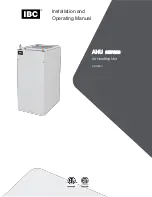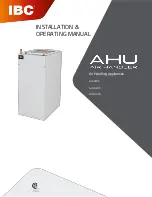
Krueger | 1401 N Plano Rd | Richardson, TX 75081 | 972.680.9136 | kruegerinfo@krueger-hvac.com | www.krueger-hvac.com
KAH Operation & Maintenance Guide
Page: 50 of 88
SECTION 3 - MAINTENANCE (CONTINUED)
CONDENSATE DRAIN PAN, TRAP AND LINE CLEANING
Tools, Equipment and Materials
•
Toilet bowl brush or similar utility cleaning brush
•
Cleaning agent (safe, commercial, disinfecting)
•
Rags and trash bags
•
Garden hose with spray nozzle or power washer
•
Scraper
•
Screening
•
Wet vacuum
Schedule and Conditions
1. Clean condensate drain pan, trap, drain line and adjacent wetted
surfaces at least annually or as often as required to retard growth
of microbial substances.
2. Test Drain Pans - To minimize conditions of water stagnation that
may result in microbial growth, field test drain pans under normal
operating conditions to ensure proper drainage.
3. Exception - Field testing drain pans is not required if units with
factory-installed drain pans have been certified (attested in
writing) by the manufacturer for proper drainage when installed as
recommended.
Cleaning Procedure
1. Cover any nearby components such as motors, control devices or
wiring.
2. Sweep, gather and remove debris from drain pan, auxiliary pans
and splash guards.
3. Scrape loose and remove any clinging substances.
4. Cover drain pan outlet with screening to prevent drain clogging.
5. Prepare cleaning agent per manufacturer’s instructions.
6. Apply cleaning agent with spray applicator or brush.
7. Apply cleaner to ALL surfaces including: underside of coil, header
and return bends if in air stream, coil supports, coil wall or bulkhead,
auxiliary drain pans, splash guards, any other surfaces subject
to wetting by condensation dripping or carried by normal airflow,
drain pan and outlet.
8. Add ample amount of cleaning agent to drain line and trap.
9. Allow cleaner to stand for time required by manufacturer’s
instructions.
10. Flush with clean water from pressure washer or garden hose with
spray nozzle.
11. Apply as much water under pressure as possible to drain outlet to
clean trap and drain line.
12. Remove water from any puddle areas with wet vacuum.
13. Wipe down if necessary to remove any stubborn material.
14. Restore equipment to operational state.
Coil Freeze Protection
All chilled water, hot water and steam coils
can be damaged during freezing weather.
Take the following re-cautionary measures
to prevent freezing:
•
For year round operation, glycol and
other antifreeze solution must be
circulated.
•
During winter operation and shutdowns
such as power failure, night shutdown
and weekend shutdown, the controls
must be installed so the valves will go
to the full heat position, and all fresh air
dampers go to the full closed position.
The water circulation pumps must keep
circulating water through the coils and/
or auxiliary heat must be maintained
inside the AHU cabinet.
•
Draining each coil and related piping
such as traps and making sure that all
low areas also drain.
•
After draining, flush the coils with an
antifreeze solution such as propylene
glycol. A solution of 50% glycol and
50% water will protect from freezing to
approximately 35°F below zero at sea
level. Use adequate mixture for the
geographic area of the installation.
•
Winterizing Drain Traps
•
During the winter months when the
cooling system is turned off, and the
unit is exposed to freezing conditions,
an anti-freeze solution, which is
environmentally friendly and safe for the
roof can be poured in the condensate
drain trap to prevent freezing and
possible damage. The condensate
drain trap may also be removed as well
as heat traced and insulated.





































